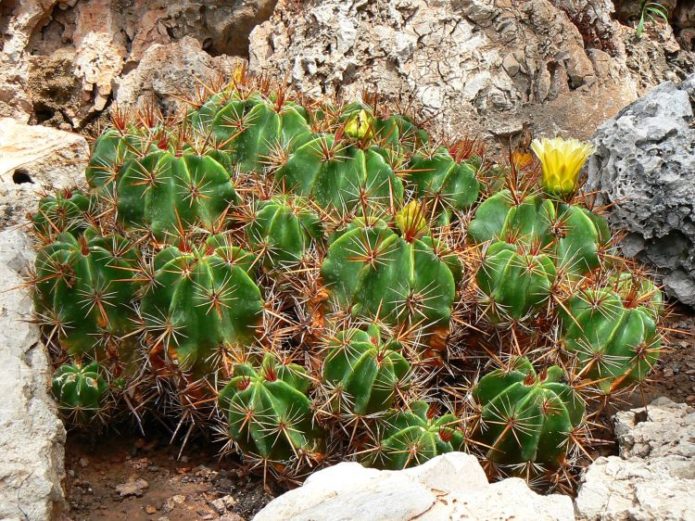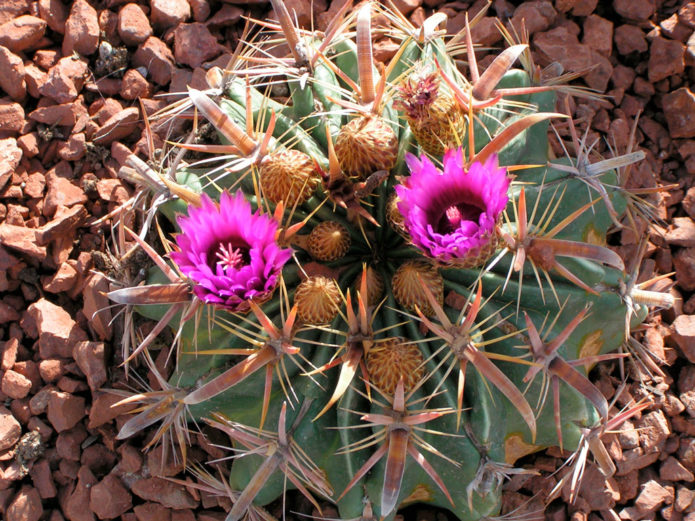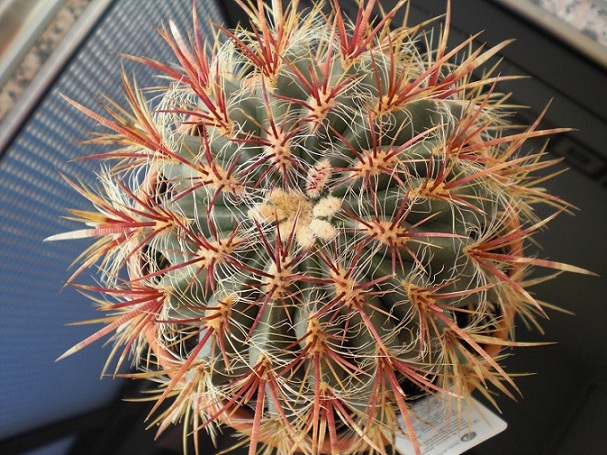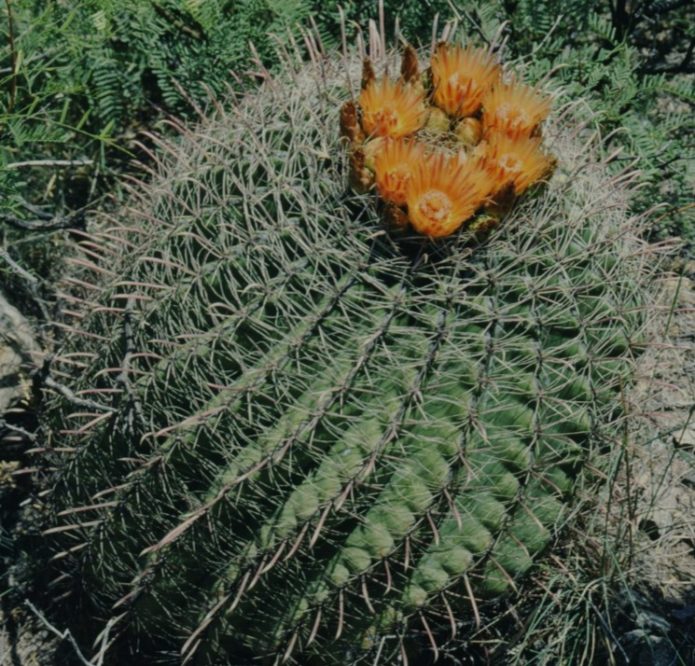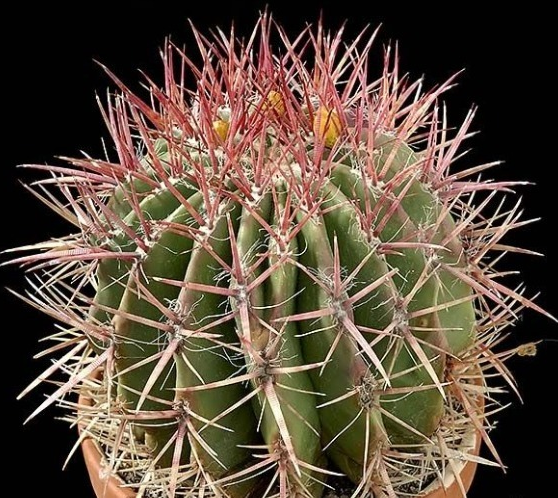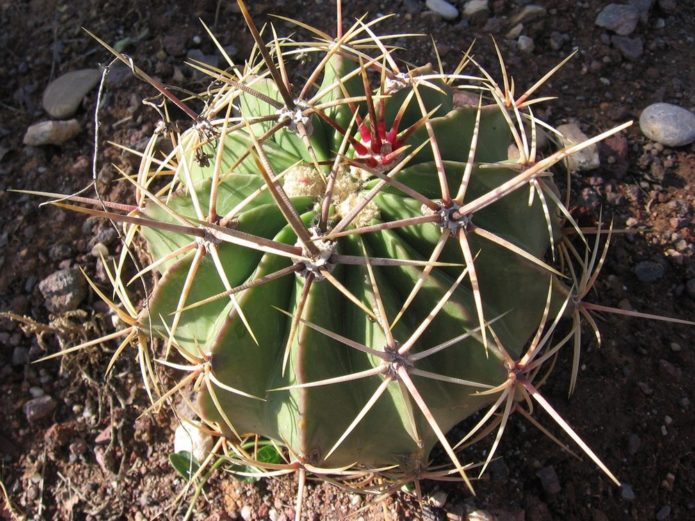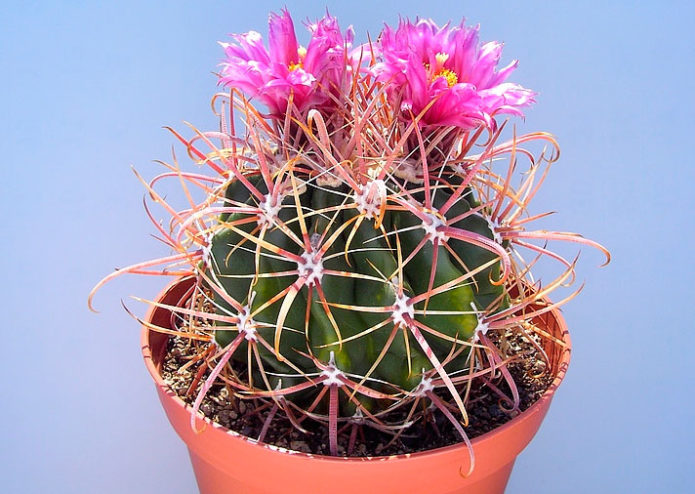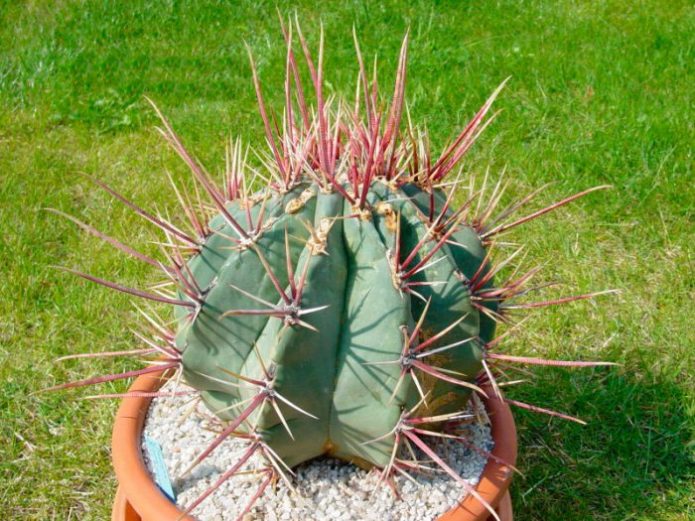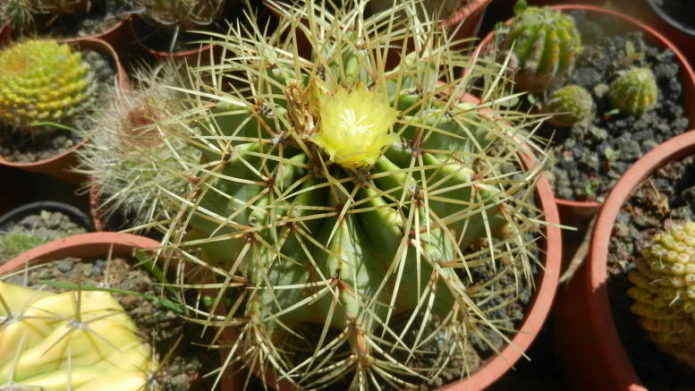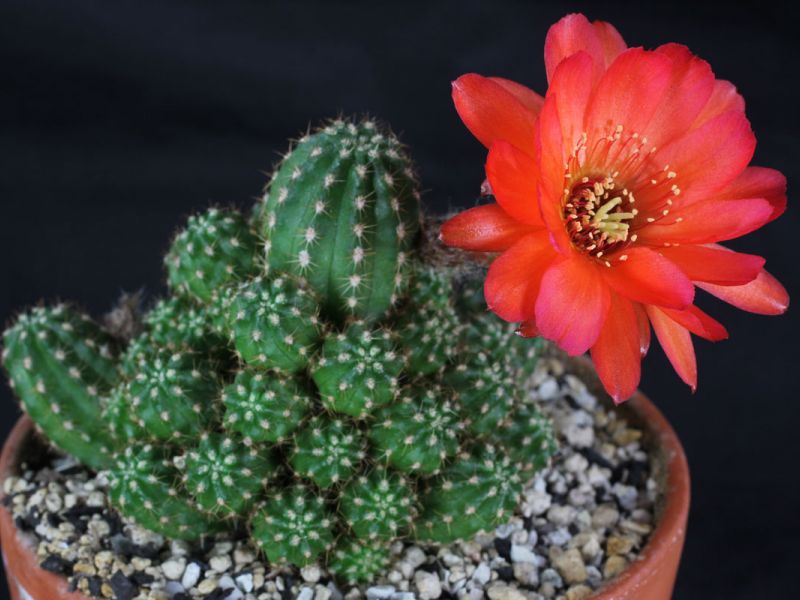Ferocactus (Ferocactus) is a genus from the cactus family, in which there are more than three dozen species. Plants are spherical and elongated. Stems are solitary or with a large number of offspring. The smallest representatives of the genus are only a couple of tens of centimeters. But there are real giants whose height in their natural habitat exceeds the height of a person.
Content
Features of growing ferocactus
In the wild, these cacti can form thickets-colonies of hundreds of individual specimens, populating an area of several square meters below them.
Ferocactuses are found in the semi-deserts of the southwestern United States and northern Mexico. They grow in high mountain areas, on depleted soils. Hence the dislike of cacti for too nutritious soils. At home, the substrate should contain at least a third of the mineral component. At the same time, there is a lot of sunshine there. For this reason, the decorative effect of the plant is lost in captivity.
Perfect solution for beginners
This is an excellent indoor plant for beginner growers that requires a minimum of maintenance. Basically, it consists in proper watering and infrequent feeding. Ferocactuses tolerate captivity well and are unpretentious to the conditions of detention. They are rarely attacked by pests and are resistant to most diseases.
Danger to children and animals
Ferocactuses do not emit hazardous substances. The flesh and ripe fruits and seeds were eaten by the aborigines. Needles were made from thorns. However, these representatives of the flora have rather long and hard spines. Therefore, the pots are placed so that children and pets do not accidentally get hurt. The needles are quite sharp and easily dig into the skin.
Beliefs and signs
There are many beliefs about cacti. It is believed that long thorns protect the inhabitants of the house from poor energy. Therefore, the pots are placed next to the TV, computer, telephone - sources of bad information.
They believe that a robber and ill-wishing guests who can damage the house will not dare to enter the house where the cactus has settled. It is believed that the presence of a cactus is capable of ruining relations in the family and relatives. Previously, it was even thought that a woman, having brought a thorn into the house, would be able to secretly expel her disgusted spouse. But the rare flowering was associated with drunkenness and an early move.
Popular varieties for home breeding: description with photo
A total of 36 species of ferocactus are known. Many of them get divorced at home.
Most plants are formed by a single stem up to 80 cm wide. Vertical triangular ribs are formed on its surface.Areoles are evenly spaced at the tops. They are flat, covered with a whitish edging, as well as sharp long needles. The top is quite fluffy, with a depression in the center.
These cacti bloom in summer. The buds form at the top or sides of the stem. They have a short tube covered with multiple scales. The petals are oblong, collected in a simple corolla. The color of the flowers is from cream to pink and red. The middle is yellow, with long anthers and ovaries. At the end of the flowering stage, oval-shaped fruits are formed. The pulp is juicy, contains several black seeds.
Ferocactus latispinus (wide-necked)
Devil's tongue (another name for the species) is one of the most attractive plants. It has a spherical, slightly flattened greenish-blue stem with 15–23 ribs. Wide-spined - the smallest species of ferocactus, the diameter rarely exceeds 40 cm.
In a large areola there are 2-4 red spines up to 8 cm long and 6-12 radial needles of pinkish color, 2 cm each. The largest spine is curved downwards and resembles the narrow tongue of a lizard. The plant is famous for its large red bell-shaped flowers - up to 5 cm in length.
Ferocactus emory
In young emori, the stem is spherical, later - cylindrical, with 22–32 high tuberous ribs. Diameter in the wild reaches 60 cm, height - from 2 m.
Areola with a brown edge. Each has 5-8 lateral spines up to 6 cm long, reddish or white in color. They can be either straight or curved at the ends. The central spine is hook-shaped, flattened, up to 6 cm long, the only one in the areola.
In summer, daytime flowers up to 6 cm in size bloom at the top, with glossy red petals and yellow blotches.
Ferocactus Vislicene
This variety of ferocactus can grow up to 2 m and is characterized by a spherical or cylindrical stem. Side shoots are absent. There can be up to 25 strong and high ribs.
Radial spines up to 5 cm long, they are thin, needle-shaped, light. The central needles are white and red, twisted, and resembles a horn in shape, up to 15 cm long.Flowers in the Vislicene species are yellow or reddish, 5 cm in diameter.
Ferocactus pilosus (Stainesi)
In pilosus, the stem is single or branching, with 13–20 ribs. There are four central spines, they are red or yellow, often flat on the sides. Length - up to 5 cm.Around the central ones there are five more spines up to 4 cm in size.The flowers are yellowish-red, grow up to 2.5 cm in diameter.
Ferocactus Histrix
Its trunk is covered with a bluish-green, velvety-looking skin, it grows up to 70 cm. The ribs are wide, high, arranged vertically. Areoles are rare, with whitish or yellowish fine needles. Radial spines reach 3 cm. In the center there are 2-3 yellow-red sharp formations up to 6 cm long. The flowers are yellow, up to 5 cm.
Ferocactus Ford
At home, a Ford does not grow more than 40 cm. It is very similar to the wide-spined species, but the central spines are thinner and paler. The flowers are large, up to 6 cm, red with a yellow tint.
Ferocactus rectilinear
The peculiarity of this species is long spines that can reach 25 cm. They are yellow-brownish, hooked and light pink at the ends. The straight-thorny appearance gives pale yellow flowers up to 5 cm in diameter.
Home care
Conditions of detention depend on the season. In order for the plant to fully develop, they must be as close as possible to their natural habitat.
| Conditions | Indicator | |
| In summer | In winter | |
| Lighting | Balcony, garden | From the south side |
| Humidity | 30–45% | 30–60% |
| Temperature | 20 ... 35 ° C | 10 ... 15 ° C |
| soil pH | 7–8 | |
Ferocactus needs fresh air, so the room is regularly ventilated, but drafts are not allowed.
The plant is rarely transplanted. Ferocactus grows slowly, its roots are poorly developed. In view of this, it does not tolerate transplants well and takes a long time to adapt to the new environment. In addition, the procedure itself is rather complicated due to the thorns.If you use thick gloves or paper, then the processes may be damaged, decorativeness will be lost.
Water the plant only when the soil is completely dry. Water is taken at room temperature, separated. Since ferocactus lives on poor soils, feeding is carried out carefully, no more than once a month. For this, fertilizers are used for cacti. Florists recommend using only half the dose indicated on the package.
During the rest period, you can not take care of ferocactus like that, it is better not to water at all if the recommended winter temperature is maintained. If it is warm in the room in winter, then the irrigation scheme is not changed.
Growing problems and their solution
With insufficient lighting, the needles decrease, some of them fall off. The plant does not tolerate cold, and at temperatures below + 10 ° C freezes and dies.
Achieving flowering from a cactus is not easy. For flowers to appear, he needs to provide a rest regime in winter. Then watering is completely eliminated and the temperature is reduced to 10 ° C. In the spring, care is resumed as usual.
Children from the stem can not be removed. But if the plant is sick, then the processes are removed. This will allow the mother specimen to recover quickly.
Overflowing temperatures that are too low will lead to rot formation. Then the cactus is removed from the soil, the affected areas are removed, the healthy ones are sprinkled with crushed coal or sulfur. The rot on the stem is removed with a sharp knife, and the living tissue is also sprinkled with sulfur.
If the nutrients are insufficient, ferocactus turns yellow. Then the feeding is increased. However, yellowness can also be associated with a virus for which there is no cure.
Diseases and parasites
The main parasites of ferocactus are:
- mealybug - formations in the form of a cotton or sticky coating, provokes the formation of a sooty fungus;
- aphids - settle on the stem, which leads to deformation of buds, shoots, the appearance of unaesthetic growths - galls;
- red spider mite.
To reduce the risk of pests on the stems, it is recommended to systematically treat with insecticides. The plant is completely moisturized for the product to work better.
Most ferocactus have nectar-producing glands at the tops of the areoles. If the substance remains on the plant for a long time, then the risk of a fungal infection increases. Infection is indicated by black formations around the areola, on the thorns, the body of the cactus. Prevention of fungus is regular spraying with soft water, preferably rainwater.
In the summer, for the prevention of sooty fungus, the pots are put out on the street. Insects love nectar, especially ants. In addition, rain baths are beneficial.
Reproduction methods
Cacti are planted in pots with large drainage holes. The soil mixture is prepared from the following components:
- leaf humus;
- sod land;
- coarse river sand or perlite (up to 70%);
- charcoal (several pieces).
The soil is pre-steamed. Also, the substrate can be purchased at the store.
Cacti are propagated in several ways - from seeds, by children, by cuttings.
Growing cacti from seeds
Seeds can be purchased from experienced florists in specialized stores. The optimal time for sowing is the end of February - April.
Cultivation includes the following stages:
- The seeds are disinfected by keeping them in a weak solution of potassium permanganate for 12 hours.
- Prepare the soil - buy it in the store or prepare it yourself.
- Fill a pot with multiple holes and a tray with the soil mixture.
- Make grooves 1 cm deep. Moisten the substrate with boiled water at 50 ° C.
- Seeds are sown in the grooves. You can also use the carpet method, when the seed is simply scattered over the soil surface. The soil is not poured on top.
- Cover the container with glass or foil. The greenhouse is opened for a few minutes a day, starting from the second week.
Further, the seedlings are provided with a suitable microclimate:
- temperature during the day - 25 ... 30 ° C, at night - about 18 ° C (you can use a fluorescent lamp, which can be turned off during daylight hours);
- the first month they keep the substrate moist, drying out will lead to the death of the sprouts, and from the second month, watering is gradually reduced (water is poured into the pan);
- the first 6 months do not give top dressing;
- shoots are protected from direct sunlight, slightly shading the vessel.
As the seedlings grow, they dive into hotel containers. The minimum distance between young ferocactus should correspond to their diameter or be large. The first shoots with proper care appear on the 3rd-10th day.
Reproduction by children
This is the easiest breeding method. But it is possible only for those species on which children are formed. Take the processes that are easiest to separate, use disinfected tweezers.
The shoots are placed on the substrate without preliminary drying, fixing them with small stones. If the roots are quite large, the young are planted directly into the ground.
But the method has a drawback - a decrease in the varietal properties of ferocactus.
Breeding by cuttings
This method will require the following tools:
- a sharp knife disinfected with alcohol;
- charcoal, pre-crushed;
- a vessel with drainage holes;
- priming;
- tweezers.
Cuttings are carried out in the following sequence:
- Cut off the healthy part of the stem, sprinkle the bottom with charcoal. They put the material in a dry, shaded place for two days so that the cut site dries.
- The substrate is poured into the pot and slightly moistened.
- A hole is laid out with small stones, a handle is placed on them so that it does not touch the ground.
- The pot is placed on the windowsill from the east or south side, but slightly shaded.
After 10-15 days, roots appear.
Growing ferocactus is an exciting experience. With the right approach, the plant will not only release long beautiful thorns, but will also delight the caring owner with abundant flowering.
